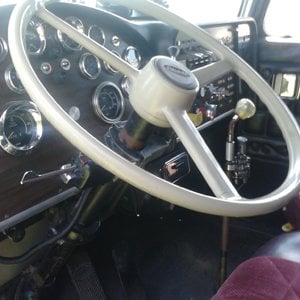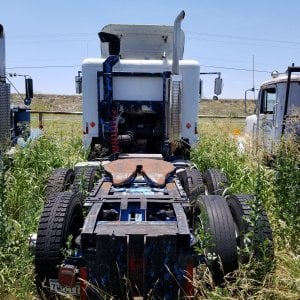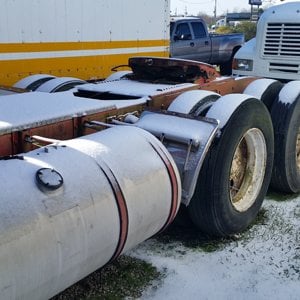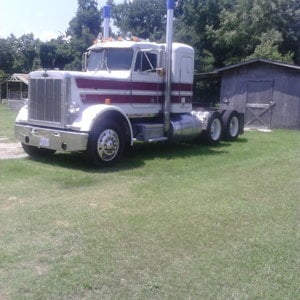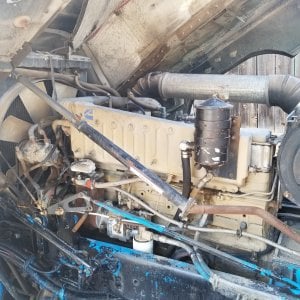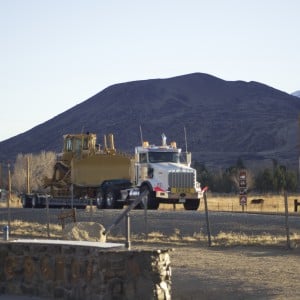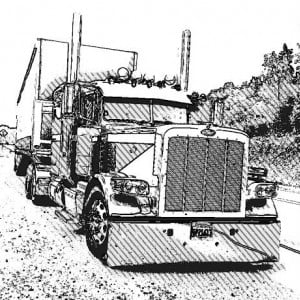Sam McCloud
Well-Known Member
Has anybody here ever driven a 5-ton tractor-trailer in the military with a day cab? I have in the army. I can tell you the army's method of coupling/uncoupling a tractor-trailer has many fewer steps than does civilian Class-8 tractor-trailers.
In the army, my 5-ton tractor would have a rear cab window through which the vehicle operator could observe when backing toward the kingpin of a parked trailer.
So to hook up, the tractor would be slowly backed toward the kingpin so the 5th wheel plate slides under the nose. Sometimes it's necessary to adjust the landing gear height if the trailer is too low or high. The V notch in the plate would be lined up with the king pin and we'd slowly back up until the kingpin was all the way home. CLICK! You'd hear it lock in place. That's how we knew it was secure. Then we'd check the release lever of the coupler to make sure it was secure. With the trailer-tractor fully coupled, we then would raise the landing leg to the up position, remove any wheel chocks from the trailer and secure them, close any air-drain valves on the trailer tanks then connect both air lines and the cable for the trailer lights. The tractor had one or two airbrake control knobs on the dash and it's been so long I can't remember what the procedure was for operating any of these knobs during trailer coupling/uncoupling but the necessary steps regarding these knobs were taken. Lastly, we would check the running lights operation of the trailer and ensure the airbrake system was charged up, the low-pressure warning buzzer was off before heading out.
Parking/dropping the trailer was basically everything above in reverse.
The CDL preschool study materials I'm reading (High Road Training Program at the TruckerTruth.com website) has all these extra steps as backing up to the trailer, actually hooking air lines and light cable up before coupling to the 5-th wheel, inspecting for any gaps between tractor and trailer 5-th wheels with a flashlight, crawling underneath the vehicle to see if the 5-th wheel locking jaws are secure around the kingpin and several other steps that weren't customarily performed in any military unit I was in.
Hooking a trailer up to an army truck was much simpler and hurry-up-and-go in nature.
Sometimes the tractor would be backed to the army semi trailer and the 5-th wheel was engaged at a slight angle and so the trailer nose slid sideways somewhat as the notch in the plate was guiding the kingpin home. This never damaged the landing legs as High Road Training suggests. Army landing legs generally have those flat feet at the bottoms and not landing gear rollers so they can slide sideways easily a few inches.
Just about every army tractor has a day cab and I can't ever recall seeing a sleeper berth on any military vehicle. When soldiers bivouac (camp in the field) they sleep in tents, sometimes in the back of a truck with enclosed cargo area as a tool van, on a truck tailgate, sometimes in a closed trailer, on a cot in the open or on the ground and usually not in any special vehicle sleeping enclosure unless you are an officer with a vehicular command post or sorts. Tankers often sleep inside their track vehicles.
In the army, my 5-ton tractor would have a rear cab window through which the vehicle operator could observe when backing toward the kingpin of a parked trailer.
So to hook up, the tractor would be slowly backed toward the kingpin so the 5th wheel plate slides under the nose. Sometimes it's necessary to adjust the landing gear height if the trailer is too low or high. The V notch in the plate would be lined up with the king pin and we'd slowly back up until the kingpin was all the way home. CLICK! You'd hear it lock in place. That's how we knew it was secure. Then we'd check the release lever of the coupler to make sure it was secure. With the trailer-tractor fully coupled, we then would raise the landing leg to the up position, remove any wheel chocks from the trailer and secure them, close any air-drain valves on the trailer tanks then connect both air lines and the cable for the trailer lights. The tractor had one or two airbrake control knobs on the dash and it's been so long I can't remember what the procedure was for operating any of these knobs during trailer coupling/uncoupling but the necessary steps regarding these knobs were taken. Lastly, we would check the running lights operation of the trailer and ensure the airbrake system was charged up, the low-pressure warning buzzer was off before heading out.
Parking/dropping the trailer was basically everything above in reverse.
The CDL preschool study materials I'm reading (High Road Training Program at the TruckerTruth.com website) has all these extra steps as backing up to the trailer, actually hooking air lines and light cable up before coupling to the 5-th wheel, inspecting for any gaps between tractor and trailer 5-th wheels with a flashlight, crawling underneath the vehicle to see if the 5-th wheel locking jaws are secure around the kingpin and several other steps that weren't customarily performed in any military unit I was in.
Hooking a trailer up to an army truck was much simpler and hurry-up-and-go in nature.
Sometimes the tractor would be backed to the army semi trailer and the 5-th wheel was engaged at a slight angle and so the trailer nose slid sideways somewhat as the notch in the plate was guiding the kingpin home. This never damaged the landing legs as High Road Training suggests. Army landing legs generally have those flat feet at the bottoms and not landing gear rollers so they can slide sideways easily a few inches.
Just about every army tractor has a day cab and I can't ever recall seeing a sleeper berth on any military vehicle. When soldiers bivouac (camp in the field) they sleep in tents, sometimes in the back of a truck with enclosed cargo area as a tool van, on a truck tailgate, sometimes in a closed trailer, on a cot in the open or on the ground and usually not in any special vehicle sleeping enclosure unless you are an officer with a vehicular command post or sorts. Tankers often sleep inside their track vehicles.
Last edited by a moderator:





